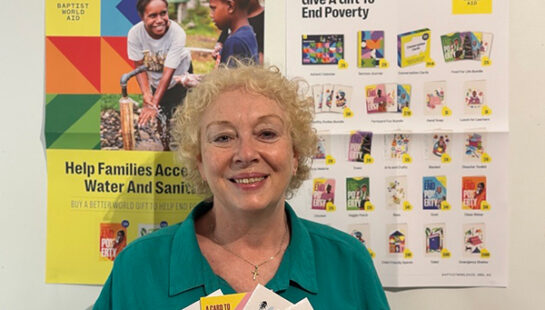Remembering The Rana Plaza Collapse
For the past eight years, my colleagues and I have marked the tragedy of the Rana Plaza collapse. In the early hours of 24th April, 2013, a garment factory in Dhaka, Bangladesh, crumbled. Within its walls were thousands of workers, many of whom never returned home to their families that night.
Over 1,130 workers perished in the collapse, with thousands more critically injured. To date, this is one of the deadliest industrial accidents in recent history.
As labels of well-loved brands surfaced amongst the dust and rubble, both consumers and brands worldwide were awakened to the daily reality facing the people who make our clothes.
Our very own first edition Ethical Fashion Report at Baptist World Aid Australia was released just weeks after the Rana Plaza collapse. And today, the issues we research in our report are as important as ever.
Look down at the clothes you’re wearing. Do you know where they came from, before you picked them out in-store or online? Do you know whose hands crafted them, or the conditions over which they were laboured? For most of us, the answer is ‘no’.
But what if we knew that the cotton in our tee-shirts has a one in four chance of being linked to one of the biggest human rights abuses of our generation? Or just how are our clothes are linked to forced labour?
One Shirt, A Hundred People
It’s estimated that 100 pairs of hands touch your clothes before they arrive in your wardrobe. That’s 100 people, each with their own story. Their own family. Their own pain and sorrow and joy. But it’s also 100 people at risk of modern slavery, poor working conditions, and exploitation.
Around the world, exploitation and forced labour are rife in fashion supply chains. The distant stages of the supply chain (such as cotton farms) are where the most egregious forms of worker exploitation occur. And COVID has exacerbated this risk even further.
In the Xinjiang province of China, it’s been reported that more than a million Uyghurs have been forcibly detained in ‘re-education camps’. Harrowing reports of abuse, rape, and forced sterilization have emerged from the region. Many of these victims are unable to return to their families in a different yet equally devastating way to the casualties of Rana Plaza.
Within these camps, it’s believed that forced labour forms a core tenet of the program. The region itself is highly agricultural, and accounts for roughly 20 per cent of global cotton production. A recent report from the Centre of Global Policy revealed that over half a million people were forced to pick cotton through a government-run labour transfer scheme.
But forced labour isn’t restricted to Xinjiang.
Forced Labour Reported In Turkmenistan, Uzbekistan And More
In neighbouring Turkmenistan, cotton harvesting also occurs through systemic, widespread forced labour. The government requires public sector workers to leave their jobs for cotton fields during annual harvests. Refusal results in penalties. It’s also been a similar story in Uzbekistan in recent years, where over a million people per year have been forcibly mobilised to harvest cotton. Child labour was also government imposed until 2012, although widespread international action in the form of sanctions has seen progress in this region.
Between Turkmenistan and Uzbekistan, this accounts for another seven per cent of global cotton production.
So, are we complicit in our fashion purchases? Who is responsible for such injustices, really?
Supply chain tracing has remained one of the fashion industry’s biggest challenges since Rana Plaza. The complexity of supply chains means that brands often have limited oversight of the subcontractors used by factories, the mills where fabrics are made, and the farms where raw materials are grown.
Progress Made, But Still A Long Way To Go
Progress has been made, but there’s still a long way to go. Since we began publishing the Ethical Fashion Report in 2013, we’ve seen a 32 per cent increase in companies who are tracing inputs suppliers (like fabric mills), and a 31 per cent increase in those tracing raw materials suppliers (such as cotton farms). But when we look at the overall statistics, this still only equates to around 18 per cent of companies tracing inputs, and eight per cent of companies tracing raw materials. It’s not enough.
Sourcing supply chains are complex global networks, and regulations differ from country to country. Some fashion companies have policies in place which address forced labour; however, far too often we see a lack of follow-through with enforcement which renders these policies of little more value than the paper they’re printed on. So where does this leave Australian consumers?
What You Can Do As A Consumer
Research commissioned this year from Baptist World Aid shows that 77 per cent of Australian consumers have heard of situations where people are working in forced labour or modern slavery. Ninety-four percent of consumers believe the Australian Government has a responsibility to pass laws restricting products made in these conditions.
While passing Australia’s Modern Slavery Act in 2018 was a step in the right direction, further legislation is currently being discussed in parliament.
As consumers, we can contribute to ending forced labour in the cotton industry by asking fashion companies to do more, or engaging with your local politicians on the issue. Cotton Campaign has some great resources for helping us navigate our choices.
And, as Christians, we are called to stand with those who face injustice and oppression. Jesus challenged power systems throughout his life, those which kept people on the margins from living life to the fullness God intended. Two millennia later, even as society is still reinforcing power systems which oppress the poor and persecute the different, God has given us the privilege and the opportunity to seek justice for those unjustly treated, to live out God’s kingdom on Earth with compassion.
The term ‘supply chain’ might seem foreign and impersonable to most, but we must remember that what it represents a chain of hands, hands made in God’s image that we must ensure are working in dignity and free of shackles.
Let’s make forced labour our new Rana Plaza call to action.
This essay first appeared in Sight Magazine on 23 April 2021.



 Sophia Russell,
Sophia Russell,

 Baptist World Aid
Baptist World Aid